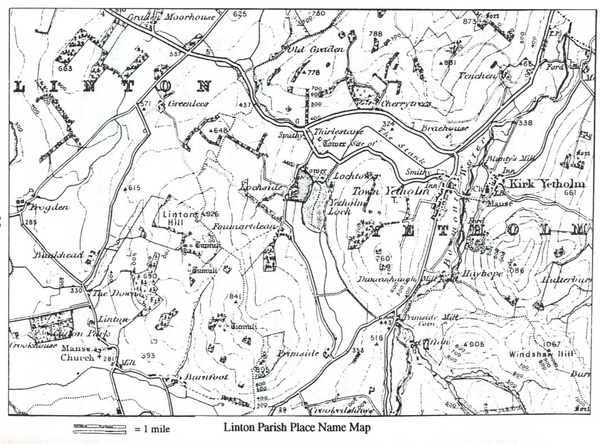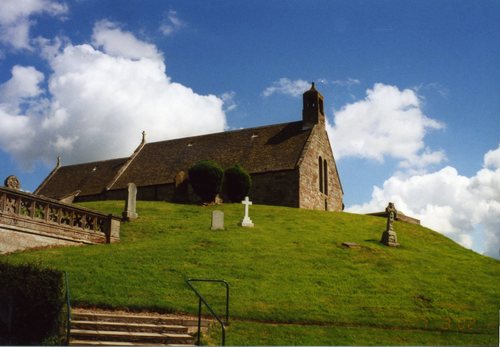Loch Lintone, Scotland
Terry L. Linton 8 1977
(first published) LINTON Chronicles Volume I, Issue 5, 8 Spring 1985
LINTON & BIRD Chronicles, Volume VI, Issue 1, Spring 8 2011, ISSN 1941‑3521
____________________
While doing the requirements to be certified by the National Association of Certified Genealogists, I ran across the leather bound book Minstrelsy of the Scottish Border, Vol. III by Sir Walter SCOTT (1771‑1832) in the Library of Congress. I spent well over a full year researching and hand coping this 1802 master piece. Sir Walter Scott, 1st Baronet was born on August 15, 1771 and died on September 21, 1832. Walter was an Scottish historical novelist, playwright, and poet, popular throughout much of the world during his time. Sir Walter Scott soured his research from The Memoire of the Somervilles written by Baron James Somerville in 1679 and the oral traditions of his family stories handed down to him.
To quote Sir Walter Scott AAt a later period, the Saxon families, who fled from the exterminating sword of the Conqueror, with many of the Normans themselves, whom discontent and intestine feuds had driven into exile,[iii] began to rise into eminence upon the Scottish borders. They brought with them arts, both of peace and of war, unknown in Scotland; and, among their descendants, we soon number the most powerful border chiefs. Such, [1249] during the reign of the last Alexander, were Patrick, earl of March, and Lord Soulis, renowned in tradition; and such were, also, the powerful Comyns, who early acquired the principal sway upon the Scottish marches. [1300]In the civil wars betwixt Bruce and Baliol, all those powerful chieftains espoused the unsuccessful party. They were forfeited and exiled; and upon their ruins was founded the formidable house of Douglas. The borders, from sea to sea, were now at the devotion of a succession of mighty chiefs, whose exorbitant power threatened to place a new dynasty upon the Scottish throne.@
Loch Lintone played a very important part in the history of Northumbria (Scotland) and forming the border between England and Scotland.
The habituation surname of Linton (spelled many different ways) is originally comes from the place name of Lintone. It is descended originally from the Strathclyde Britons, This ancient, founding race of Scotland were a mixture of Gaelic/Celts whose original territories ranged from Lancashire in the south, northward to the south bank of the River Clyde (Chluaidh) in Scotland. From 400 A.D. to 900 A.D. their territory was overrun firstly by the Irish Gaels, then the Angles from the east, and, finally the Picts and Dalriadans from the north. However, their basic culture remained relatively undisturbed. By 1000 A. D. the race had formed into discernible Clans and families, perhaps some of the first evidence of the family structure in Britain. [iii]
Loch Linton, Scotland. According to the winter of 1085 Domesday Book, the original spelling is Lintone. Loch Lintone separated the villages of Lintone and Morebattle in Northumbria Scotland. In 1085, Lock Lintone was located in the County Yorkshire wastelands. The waste is mentioned on every page and the blame is usually placed on the deviation wrought by AWilliam=s hurrying of the North@ in the winter of 1069 and 1670. This waste was all caused by attacks by the Vikings and the Scots Parish Lintone is about six miles in length and two miles in breadth, and is bounded on the east by the county of Northumberland. The parish comprises about 6500 acres, of which nearly 5500 are arable, eighty woodland and plantations, and the remainder rough pasture and 1000 acre lake. The surface rises in gentle undulations from a rich and fertile vale near its western boundary, and is enclosed on the north by a range of hills, of which Kiplaw, Hoselaw, and Blakelaw are the principal. The larger of the two lakes from which the parish took its name was nearly circular in form, and had an area of about 1000 acres it was surrounded by hills of considerable height cultivated to their summit, except on the west, where was a valley through which its superfluous waters found their way into the river Kale. Loch Lintone contained over 1000 acres of water and marsh, it dominated the area in 1085. Lock Lintone was fed by the Kale Water, a tributary of the River Teviot and a tributary of the River Tweed. Loch Lintone has virtually disappeared as a result of the extensive drainage in the 19th century to improve Kelso=s agriculture. The remains of Lock Lintone bank=s can be seen as terraces at mouth of the Kale Valley leading up to the village of Hownam. The old road from Morebattle to Linton via Linton Burnfoot, and on to Kelso was built around the side of the shrinking loch, the new road crossing the old loch bed. Today there is the River Kale and the very swampy area left, at the east end of the valley, after the drainage efforts of the 18th Century, during the great agricultural improvements thrust in the Borders. The land recovered from the bed of the loch proved very fertile and excellent for arable farming. The village of Linton in Parish Linton is located just outside of Kelso, old County Roxburgh, 6 miles (South East by South) from Kelso in present day County Scottish Borders, Scotland.
The Tryst still stands on Lock Linton, in the parish of Linton, near Roxburghshire, there is a circle of stones, surrounding a smooth plot of turf, called the Tryst, or place of appointment, which tradition avers to have been the rendezvous of the neighboring warriors. The name of the leader was cut in the turf, and the arrangement of the letters announced to his followers the course which he had taken. The Linton Dragon or the Terrifying Tale of the Linton Worm, By Martin Somerville (1796-1856), 1845 Montreal Gazette LINTON & BIRD Chronicles Volume I, Issue 5, © Spring 1985. The ancient race of Somerville's played an important part in Linton's history and legend. The original Walter de Somerville came over from Normandy with William the Conqueror. A descendant, William was knighted by Bruce.
During the 12th century the people of Linton were kept in a state of great distress because of a terrible monster or "Worm." (orme or worme is the ancient Norse for serpent) A 12th century writer described it as "In length three Scots yards and bigger than ordinary man's leg in form and callour to our common muir edders."The monster lived in a hollow on the side of Linton Hill, a spot still known as the "Worm's Den." from its lair it crept all over the countryside and kept people in constant terror. Somerville of Lariston, having heard so many tales was determined to see the beast and work out a plan for its destruction. He rode to its den at dawn, when the beast crawled out to find a horseman so near, "It lifted its head and half its body and for a long time stared him in the face with open mouth," after which it crept back into its den without doing him any harm. Somerville hit on an ingenious plan to get rid of the beast, he noted that it invariably stared an observer the face with open mouth, so he had a long lance made of great strength with a wheel near the point which turned very easily. On the point of the lance he placed a lighted peat daubed with pitch. For many days he rehearsed his proposed attack, so that the horse would become used to the smoke blowing in its face.Then in spite of many sceptics among his neighbors he set out for the "Worm's" den accompanied by a servant. Whenever the beasts head appeared the servant lit the peat, then spurring his horse to full gallop Somerville charged the monster and thrust his lance with the burning peat into its open mouth and down its throat. The fatal blow had been dealt, In the pangs of death the monster raised up the whole ground that was above her (part of her body being still in the den) and overturned the same to the furthering of her ruin. For his heroic deed Somerville was appointed Royal Falconer, honoured with a Knighthood and made First Barrone of Linton. The crest of the Somerville's was wyvern (heraldic dragon) perched on a wheel. The peerage is now extinct. [viii] Linton Tower was the family's stronghold for close on two and a half centuries, and their bones were buried in the chancel of the church. The tale of how Somerville of Lariston slew the "Worm" of Linton and was rewarded with the Barony, is traditional in the Borders.On Lock Linton stud Linton Tower, the moated castle keep of the Somervilles stood on the lake on a knoll a few hundred yards east of the church, the two buildings were so close that an underground passage may have existed. It is still possible to trace the general outline of the castle, though nothing now remains of this ancient tower. In addition to this Somerville stronghold, there were several other towers in the parish at one time. At the end of the Din Moss near Hoselaw, stood Garden Tower the stronghold of the Ker's, Hoselaw Peel stood close to Hoselaw Chapel while Sharprig Tower occupied a site on the farm of Frogden, no trace of any of these buildings survives.
Footnotes:
. Minstrelsy of the Scottish Border, Vol. III Consisting Of Historical And Romantic Ballads, Collected In The Southern Counties of Scotland; With A Few Of Modern Date, Founded Upon Local Tradition Author: Walter Scott, In Three Volumes. Printed by James Ballantyne and Co. Edinburgh Fifth Edition. Printed for Longman, Hurst, Rees, Orme, and Brown, London ; and A, Constable and Co. Edinburgh. 1821.
. Minstrelsy of the Scottish border, Volume 1 The Minstrelsy of the Scottish Border (1802‑1803) Sir Walter Scott, is a collection of Border ballads compiled by Walter Scott. Printed by James Ballantyne and Co. Edinburgh Fifth Edition. Printed for Longman, Hurst, Rees, Orme, and Brown, London ; and A, Constable and Co. Edinburgh. 1802. Page 34.
. Hounam and Linton, Borders Family History Society in Roxburghshire Monumental Inscriptions Vol I. 8 1890.
. The Domesday Book England=s Heritage, Then and Now. Created and Produced by Phoebe Phillips Editions, Published by Crown Publisher Inc., copyright 8 Phoebe Phillips Editions 1885, ISBN 0-517-558668-8. pages 302-334
. Hounam and Linton, Borders Family History Society in Roxburghshire Monumental Inscriptions Vol I. 8 1890.
. Definition: tryst a noun 1.an appointment to meet at a specified time and place, esp. one made secretly by lovers 2. a .a meeting held by appointment b. the place of such a meeting also 3. Scottish a market or fair, esp. for cattle Origin: ME triste, var. of tristre < O Fr, hunting station, hence hunting rendezvous. transitive verb, intransitive verb: to agree to meet. From YourDictionary.com
. Minstrelsy of the Scottish border, Volume 1 The Minstrelsy of the Scottish Border (1802‑1803) Sir Walter Scott, is a collection of Border ballads compiled by Walter Scott. Printed by James Ballantyne and Co. Edinburgh Fifth Edition. Printed for Longman, Hurst, Rees, Orme, and Brown, London ; and A, Constable and Co. Edinburgh. 1802. Page 43.
[viii] THE TERRIFYING TALE OF THE LINTON WORM By Martin Somerville (1796-1856) 1845 Montreal Gazette LINTON & BIRD Chronicles Volume I, Issue 5, © Spring 1985
LINTON Chronicles
BIRD Chronicles
Sign Kirk's Guest Book
LINTON Family Tree
BIRD Family Tree
The LINTON & BIRD Chronicles on Facebook
Thanks for Visiting, come back when you can stay longer!
Below photo: Church Linton on Linton Hill overlooking where Lock Lintone once layed.
*

